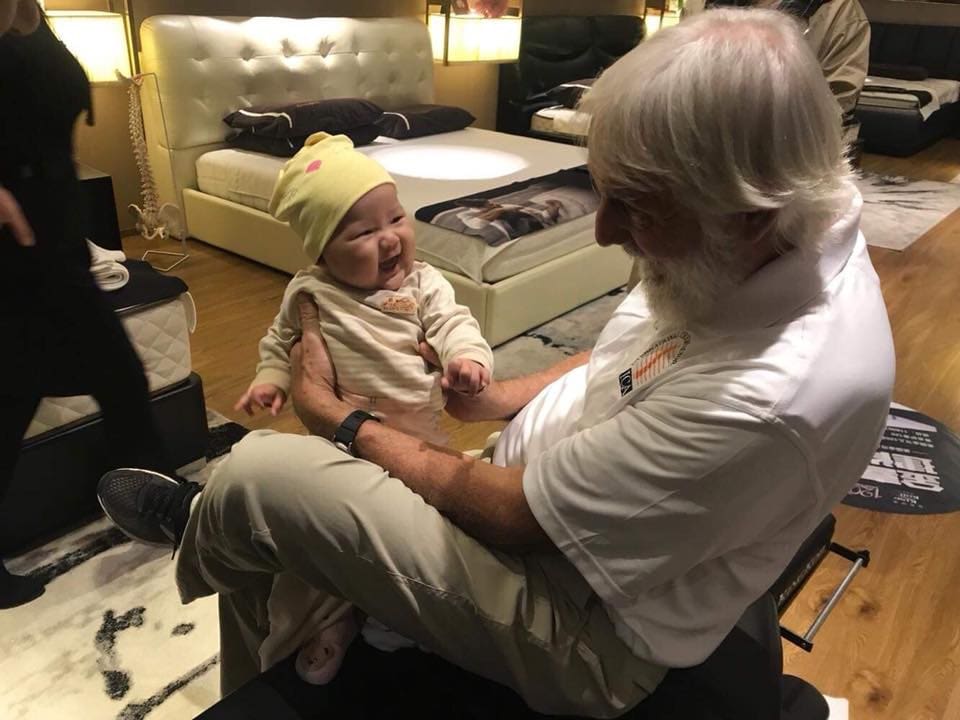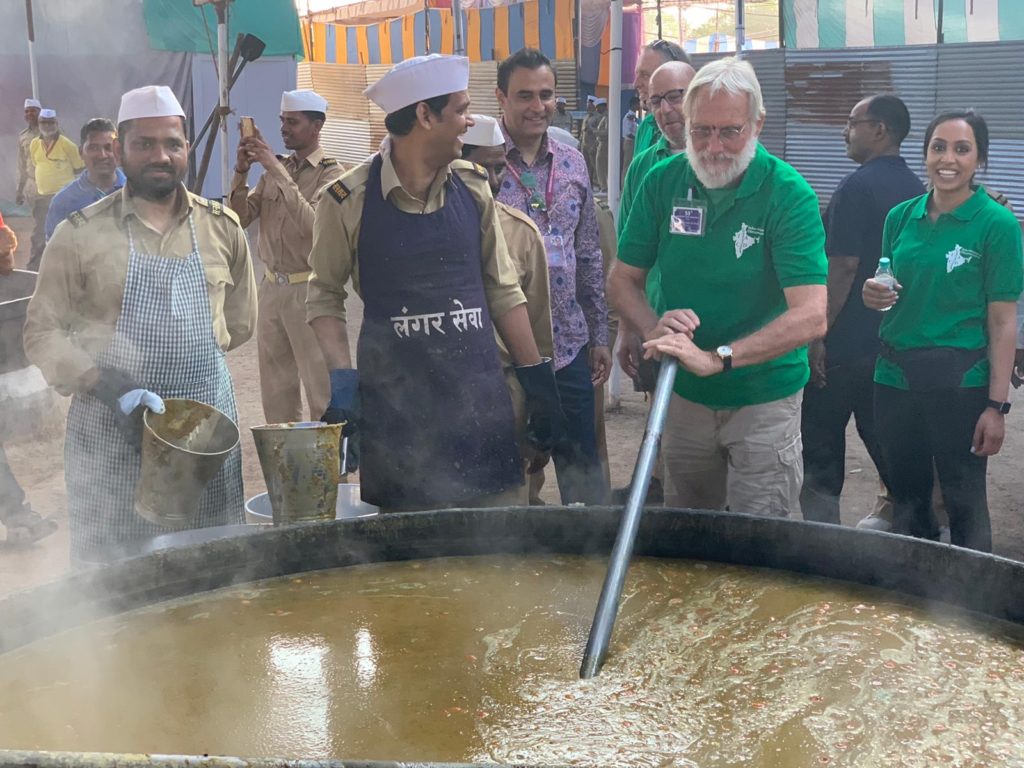
Dr. Robert De Bonis, a chiropractor in Coral Bay better known as “Dr. Bob,” found there truly was a silver lining when Hurricane Irma destroyed his office.
“The International Chiropractic Association had been wanting me to take an active role in promoting chiropractic for a number of years, but I could never make the commitment,” said De Bonis. With the loss of his office, however, he decided to take the opportunity to travel.
De Bonis joined a group of eight western chiropractors traveling in China. Accompanied by interpreters, they fanned out, each taking a different route, to treat tens of thousands of patients. Since 2017, De Bonis has been to 30 cities in China on four different trips. “They treat me like a rock star,” he said, his eyes revealing a smile mostly concealed by his face mask worn throughout the interview – a sign of the current COVID-19 pandemic.
Though chiropractic was not known in most places he went, the basic idea is not a strange concept for the Chinese. “Chiropractic and eastern philosophy are well-matched,” De Bonis said.
“Chiropractors understand that there’s an ‘intelligence’ or power to the energy that dwells in everyone,” he said. “The Chinese call it ‘Chi.’ This intelligence uses the brain, spinal cord – the entire central nervous system – as the master communication system.”

“When you’re healthy and you’re functioning correctly, all the body parts are getting the necessary information from the brain and giving necessary feedback to the brain. There are literally millions and millions of signals all the time” regulating blood pressure, kidney functions, the digestive system – all of the body’s functions, De Bonis said.
“Chiropractors are trained to detect and correct nerve blockages. When a spinal bone [vertebra] is out of alignment, it is the first step in disease – a lack of harmony in the body. I check the spine, find imbalances and correct them.” He compared the body to a well-tuned instrument. “There’s a correct tone, like a guitar string. That’s why everyone should come in for a tune-up.”
Chiropractic was developed by D.D. Palmer in Davenport, Iowa, in 1895. Palmer’s first patient was Harvey Lillard, an African American, who bent over, felt a pop and subsequently lost most of his hearing. As De Bonis tells it, “D.D. found a lump on Miller’s neck, ‘mashed on it,’ and Miller reported his hearing improved so much that he ‘could hear the wagon wheels on the cobblestones.’ That impressed D.D. so much he spent the next 15 years researching how a bone out of place affects the body’s functioning.”
De Bonis said many cultures have developed similar practices, with families often passing down the skills through generations. In the Caribbean, traditional healers known as “rubbers” set bones and heal injuries. Chiropractic and osteopathy are the two major modern western medical practices that focus on joint manipulation.
To qualify for a degree, chiropractors take 5,000 hours of academic training, taking courses in anatomy and physiology that are almost identical to those required in medical schools. Like traditional medical doctors, they honor the Hippocratic Oath, “First, do no harm.”
“We screen people,” said De Bonis. “How you treat a 97-year-old with osteoporosis is different from how you’d treat a healthy middle-aged person. For a baby, you’d use the amount of pressure you’d use on an eyeball. It would be different for a 250-lb guy who lifts rocks all day. I do what’s appropriate, as little as possible, so the body can do the most.”

De Bonis was impressed by the differences between the overall health of the populations of the U.S. and China.
“In China, I found more people needed less care. It has to do with the eastern lifestyle. At 9 p.m. you’d find in the town square someone with a little speaker and a microphone, and elderly women and men line dancing. They’ve adopted a healthier lifestyle.” However, with the increased availability of American fast food in China and a love of “all things American,” De Bonis wonders if this will change.
Throughout his travels in China, De Bonis said he felt safe, and he came to realize it was largely because of the presence of surveillance cameras everywhere. His interpreters laughed at him when he automatically picked up his bags to keep them with him when he went to enter a Starbucks in a railroad station. “‘You can leave the luggage; you can leave a $100 bill on your luggage. It will be there when you return,’ they said. Of course, they pay a price for all that surveillance,” De Bonis added.
De Bonis was in the habit of being mindful of his safety in urban places. A New Yorker by birth, he spent 30 years practicing chiropractic medicine in Manhattan.
He and his wife Susan came to St. John in the 1990s for vacation, and like so many others, fell in love with the beauty and pace of island living. Upon deciding to leave city life behind, he set up a small office in the Coccoloba Shops in Coral Bay and started seeing patients in 2006.
One day he got a call from Dr. James Clayton, the founder of Cruz Bay and Red Hook Family Practices. Knowing that medical doctors and chiropractors don’t always agree on what constitutes sound medical practice, De Bonis was a little dubious when Clayton asked to meet. When they sat down for lunch at the Westin, Clayton said, “You’re getting some fantastic results with my patients … maybe you can help me with my problems.”
Within a short time, Clayton provided space for De Bonis to see patients in his offices, and De Bonis found himself working six days a week on two islands, in three locations. “My wife said to me, ‘Bob, remind me, why did we move to St. John?’”
De Bonis cut back to just his Coccoloba location, where he remained until Hurricane Irma left him with a couple of rain-soaked diplomas and a portable table for treating patients.
He took that table to the firehouse in Coral Bay to adjust anyone who needed it following the hurricane. One day, when adjusting a first responder who arrived on St. John from New Jersey, the man looked up and said, “Don’t I know you? You adjusted me at the Javits Center in New York City after 9/11.”
De Bonis was amazed at being recognized after all those years.
“You see, with a little portable table, I can provide care,” he said.
In the last two years, De Bonis has also made two trips to Tonga, an archipelago nation in Polynesia, and one trip to India, where more than a million followers of a guru gathered in a tent city north of Mumbai.

“We were labeled as ‘miracle workers’ there,” said De Bonis. He told of one incident where a man in a coma was carried into the tent. “I asked, ‘What happened?’ They said, ‘Six months ago he was fine, then he fell over, and he’s been in this state since then.’”
De Bonis said he laid the patient on the table, adjusted his atlas bone (at the top of his spine) and the patient woke up, startled. His wife began to cry. The patient came back twice more over the next two days, “And by the third day, he could get up and walk around a bit as I held his hands,” De Bonis said.
He later learned that his treatment had further repercussions: The patient’s children no longer had to stay home to care for him but could return to school and continue their education. “Who knows what now will happen for that family?” said De Bonis.
Family is especially important to De Bonis. At the age of nine, he learned he was adopted. Later he learned he was one of eight children in his birth family, and after connecting with them, realized he must have crossed paths with some of them in his years living in New York.
Aside from traveling for his chiropractic work, De Bonis usually travels to visit his three adult sons who live in the states; the youngest is a kombucha brewmaster and food truck manager; the second is a videographer; and the oldest is a now also chiropractor.
De Bonis remembers being a young chiropractor and holding his first son, then a baby, who was suffering from a fever. De Bonis thought first about taking him to the emergency room. Instead, he adjusted him and felt the child’s temperature cool as he held him in his arms. De Bonis said it was a defining moment for him.
He shared that story as the guest speaker at his oldest son’s graduation from chiropractic college, telling the graduates that he looked forward to them experiencing the same kind of defining moments.
Editor’s note: This story has been updated since it was first posted to correct the name of D.D. Palmer’s first patient. The Source regrets the error.





